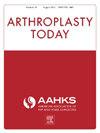Factors Affecting the Elevation of Inflammatory Markers Before Primary Total Hip Arthroplasty
IF 1.5
Q3 ORTHOPEDICS
引用次数: 0
Abstract
Background
Abnormal inflammatory marker levels are often detected in patients who have multiple comorbidities before primary total hip arthroplasty (THA) without a specific infection. This study aimed to examine the prevalence of the elevation of inflammatory markers, distribution of inflammatory markers, and factors affecting the elevation of inflammatory marker levels before primary THA.
Methods
A retrospective review of 511 THA cases from the outpatient clinic of a single institution was conducted. Patients were divided into 2 groups with normal (group A: n = 432) vs abnormal (group B: n = 79) C-reactive protein (CRP) values using threshold for the upper limit of normal of 0.5 mg/dL. Preoperative diagnoses and underlying diseases of the patients were reviewed. Underlying diseases and medical history included autoimmune inflammatory disease; diabetes mellitus; chronic kidney disease; histories of cancer, organ transplantation, and contralateral hip arthroplasty; and preoperative urinalysis. The distribution of inflammatory markers, prevalence of preoperative diagnosis, and underlying diseases were compared.
Results
The prevalence of elevated CRP levels was 15.5%. Mean values of all inflammatory markers were significantly lower in group A. The risk of elevated CRP was higher with osteonecrosis of the femoral head (ONFH) and subchondral insufficiency fracture of the femoral head (SIFFH) compared to hip arthritis (ONFH: odds ratio = 3.03; SIFFH: odds ratio = 4.85). The prevalence of autoimmune inflammatory disease was higher in group A than in group B. No difference in the prevalence of other underlying diseases was observed between the groups.
Conclusions
Elevated inflammatory markers are commonly observed before primary THA. Although the distribution of inflammatory markers was different, only CRP level was different based on normal range. Regarding preoperative diagnosis, ONFH and SIFFH significantly influenced the elevation of inflammatory marker levels compared to hip arthritis. Regarding underlying diseases, autoimmune inflammatory disease was the only significant factor affecting the elevation of inflammatory markers.
求助全文
约1分钟内获得全文
求助全文
来源期刊

Arthroplasty Today
Medicine-Surgery
CiteScore
2.90
自引率
0.00%
发文量
258
审稿时长
40 weeks
期刊介绍:
Arthroplasty Today is a companion journal to the Journal of Arthroplasty. The journal Arthroplasty Today brings together the clinical and scientific foundations for joint replacement of the hip and knee in an open-access, online format. Arthroplasty Today solicits manuscripts of the highest quality from all areas of scientific endeavor that relate to joint replacement or the treatment of its complications, including those dealing with patient outcomes, economic and policy issues, prosthetic design, biomechanics, biomaterials, and biologic response to arthroplasty. The journal focuses on case reports. It is the purpose of Arthroplasty Today to present material to practicing orthopaedic surgeons that will keep them abreast of developments in the field, prove useful in the care of patients, and aid in understanding the scientific foundation of this subspecialty area of joint replacement. The international members of the Editorial Board provide a worldwide perspective for the journal''s area of interest. Their participation ensures that each issue of Arthroplasty Today provides the reader with timely, peer-reviewed articles of the highest quality.
 求助内容:
求助内容: 应助结果提醒方式:
应助结果提醒方式:


